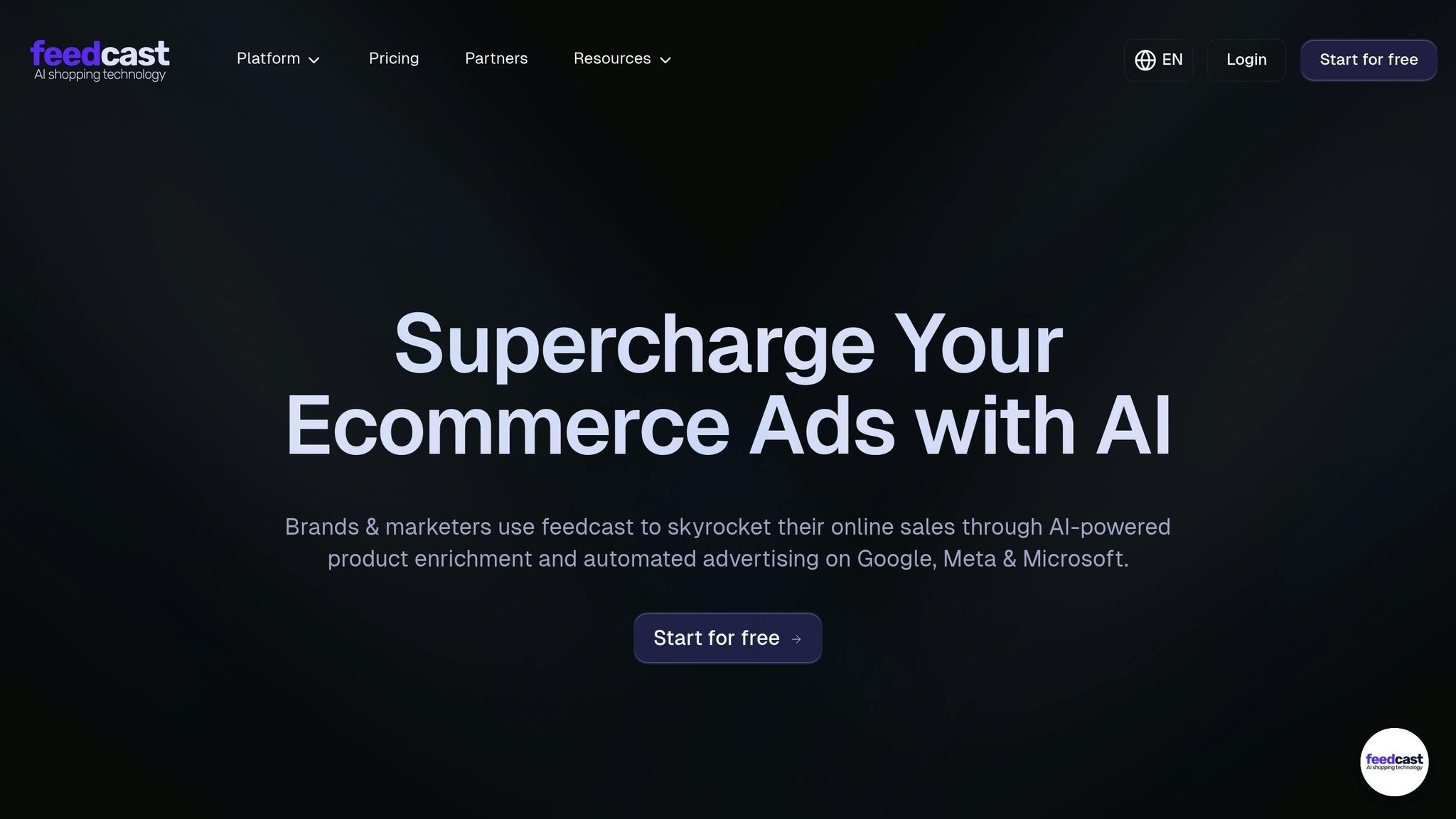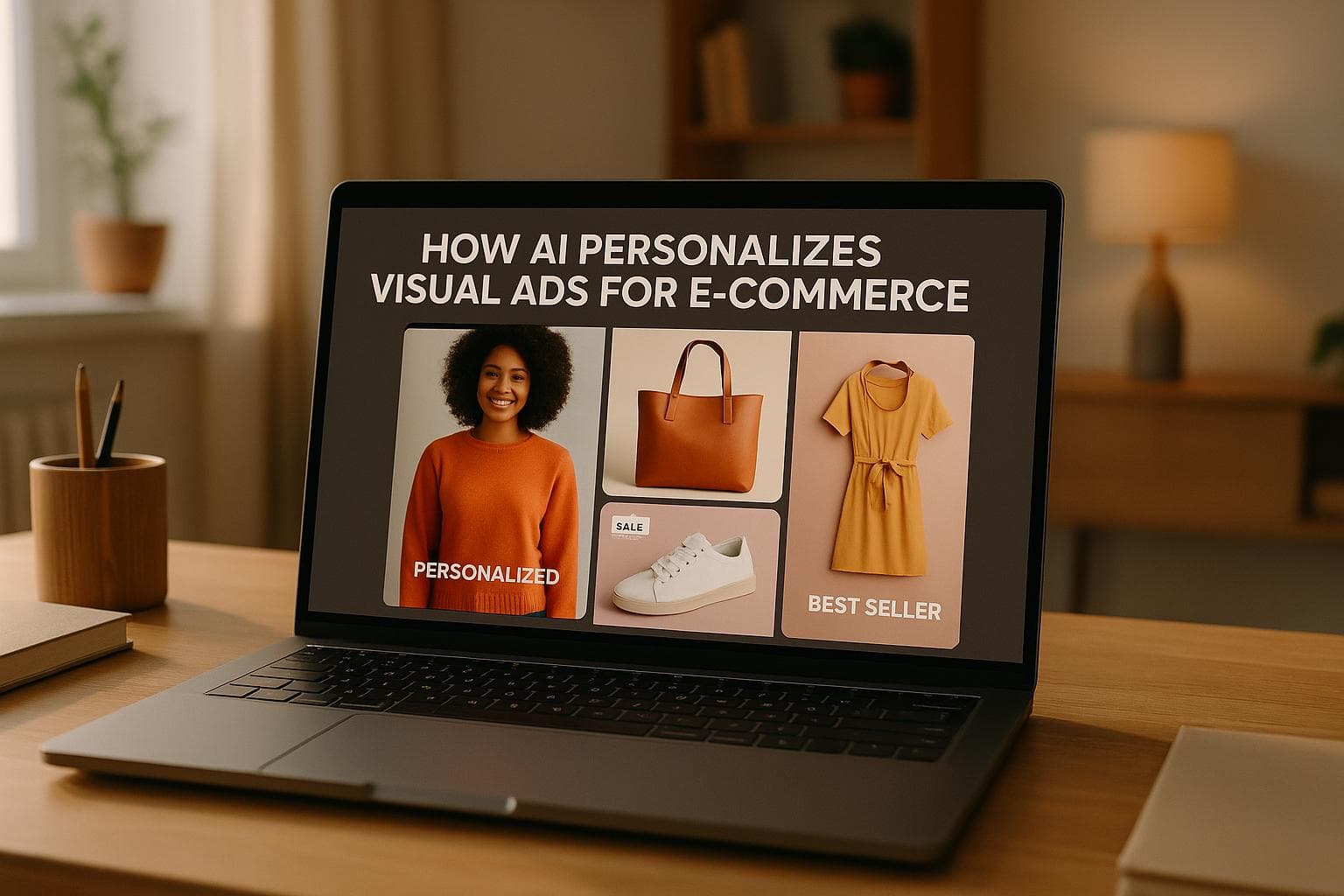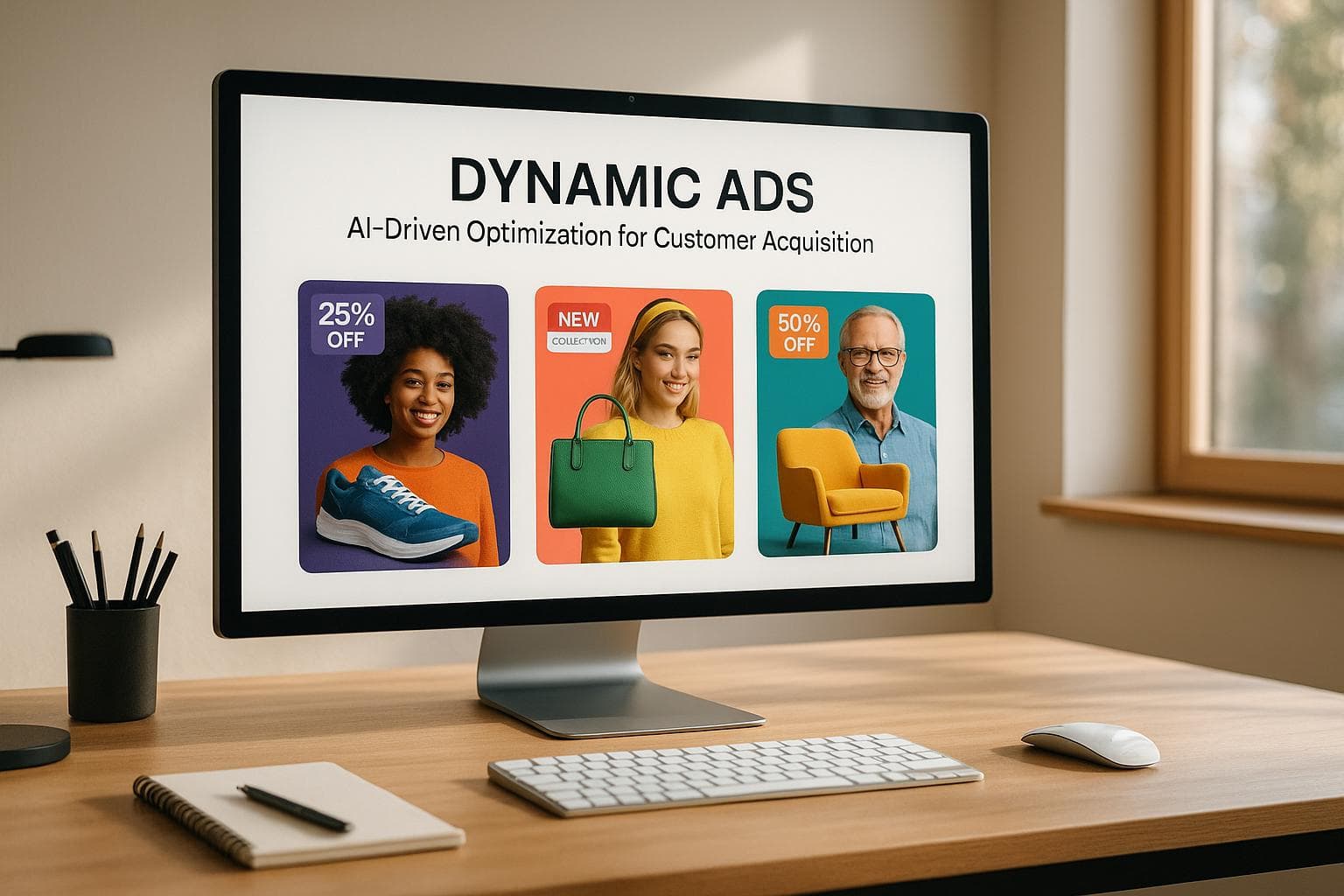How AI Personalizes Visual Ads for E-commerce
Learn how AI is transforming e-commerce advertising by creating personalized visuals that boost engagement and sales while reducing costs.
AI is reshaping e-commerce ads by creating highly personalized, data-driven visuals that connect with individual shoppers. Instead of generic campaigns, AI uses customer data like purchase history and browsing habits to craft ads tailored to preferences. This approach boosts engagement, increases sales, and reduces costs. For example, AI can generate thousands of ad variations in hours, target specific platforms, and even integrate features like virtual try-ons or AR.
Key takeaways:
- Personalized ads improve click-through rates by up to 50% and reduce cost-per-acquisition by 30%.
- AI automates ad creation, saving time and cutting production costs by up to 80%.
- Platforms like Feedcast.ai simplify ad management, optimize campaigns, and centralize analytics.
E-commerce businesses leveraging AI gain a competitive edge, offering tailored experiences that drive better results across platforms.
how i turn product images into (animated) video ads using AI.
How AI Creates Personalized Visual Ads
The secret behind AI-driven visual ads lies in how these systems transform customer data into highly targeted, engaging content. Instead of relying on broad assumptions or generic approaches, AI dives deep into individual behaviors and preferences to craft ads that feel tailor-made for each shopper.
Turning Customer Data into Tailored Visuals
AI kicks off the process by analyzing a treasure trove of e-commerce data. This includes purchase history, browsing habits, search queries, and engagement patterns. These data points serve as the foundation for creating ads that speak directly to individual customers. For example, AI can track what items a shopper has viewed, added to their cart, or even abandoned, using that information to predict what might catch their attention next.
Imagine a customer who often browses athletic gear and recently purchased running shoes. AI could generate visuals showcasing related products like workout clothes or fitness accessories, creating a seamless shopping experience.
A standout example of this is Cadbury India's "Shah Rukh Khan-My-Ad" campaign from October 2023. Collaborating with Ogilvy India, Cadbury used AI to create over 130,000 unique video ads for small businesses. Each ad featured Shah Rukh Khan personally mentioning a local store by name, with geo-targeting ensuring the content reached the right audiences. The result? Impressive engagement and conversion rates[4][1].
The magic happens when demographic details like age, gender, and location are combined with behavioral insights, such as how long someone spends on a site or their seasonal shopping habits. AI platforms pull this data from website analytics, CRM systems, and e-commerce tools to build detailed customer profiles. These profiles guide every creative decision, enabling AI to design visuals that resonate on a personal level and adapt in real time.
Streamlining Ad Design with AI
Once AI has a clear understanding of its audience, it shifts into creative mode, automating the design process. Modern AI tools can generate images, write ad copy, and fine-tune layouts based on audience insights and campaign goals. This automation not only eliminates the need for manual design but also allows businesses to produce a wide variety of ads quickly.
With AI, scaling personalized advertising becomes effortless. Thousands of unique ad variations can be created to cater to different customer segments - something that would be impossible with traditional methods.
Take Meta's AI Sandbox, for instance. This tool enables advertisers to automatically generate multiple text and image variations, crop visuals for specific placements, and streamline campaign creation. Businesses can test different creative ideas without spending weeks on manual design work[2].
The time savings are a game-changer. What once took days or weeks can now be accomplished in hours. This agility allows businesses to adapt quickly to market trends, seasonal shifts, or inventory updates. For example, Nike’s AI-powered campaign celebrating Serena Williams’ anniversary reached nearly 1.7 million viewers on YouTube, showing how AI-generated content can drive massive engagement[2].
Customizing Ads for Every Platform
AI doesn’t just stop at creating personalized visuals; it ensures these ads fit seamlessly across all platforms. Each platform - whether it’s Google, Facebook, Instagram, or Microsoft Ads - has its own set of specifications for image sizes, aspect ratios, text limits, and formatting. AI handles these technical details effortlessly.
Through automation, AI resizes, crops, and reformats creative assets to match each platform’s requirements while maintaining a cohesive look and feel. For instance, a single product image can be transformed into a square format for Instagram posts, a vertical layout for Stories, a horizontal banner for Facebook, or various sizes for Google Shopping ads.
Platforms like Feedcast.ai simplify this cross-platform optimization even further. Their AI tools enrich product data, generate personalized ad copy, and fine-tune campaigns for specific audiences across Google, Meta (Facebook and Instagram), and Microsoft Ads - all from one centralized dashboard. This approach ensures visual ads remain consistent while being perfectly tailored to each platform’s unique needs.
AI also adapts content based on platform-specific best practices. For example, it might prioritize lifestyle imagery for Instagram, highlight product details for Google Shopping, or create socially engaging content for Facebook. By aligning with each platform’s strengths, businesses can maximize performance without needing separate creative teams for every channel.
Benefits of AI-Powered Visual Ad Personalization
AI has completely reshaped how ads are created, and its ability to personalize those ads brings undeniable advantages. By combining creativity with efficiency, AI-powered personalization takes digital marketing to new heights, helping e-commerce businesses form deeper connections with their customers. This isn't just about automating tasks - it's about improving every aspect of marketing performance.
Higher Conversion Rates and Customer Engagement
When ads feel personal, they spark action. AI-driven personalization can double or even triple click-through rates and boost conversion rates by as much as 30% compared to traditional advertising methods[2][3]. The magic lies in delivering tailored content at scale, which results in more meaningful interactions and stronger bonds with customers.
Lower Costs and Faster Ad Production
Creating ads the old-fashioned way often involves countless design revisions, which drain both time and money. AI changes the game, cutting production time by up to 80% and slashing costs by half compared to conventional methods[2][3]. Tools like Feedcast.ai make this process even smoother by automatically generating personalized ad copy, optimizing product images for different platforms, and producing multiple ad variations for testing. This automation speeds up campaign launches and reduces the need for expensive photo shoots or extensive graphic design work.
On top of that, businesses using certified Google CSS partners like Feedcast.ai can save an extra 20% on Google Shopping campaigns[6]. AI’s ability to generate numerous ad versions also makes A/B testing much easier, helping marketers quickly identify what works best - all while keeping costs low. These efficiencies allow for campaigns that are not only faster but also continuously refined for better results.
Better Campaign Performance and ROI
AI doesn’t just save money; it makes campaigns smarter. Instead of relying on static setups, AI analyzes performance data in real time, adjusting targeting, creative elements, and budgets to get the best outcomes. For example, Feedcast.ai has driven millions of clicks and generated millions of dollars in sales for over 3,000 e-commerce brands[6]. This approach reduces cost-per-click, increases conversion rates, and ensures ad spend is used effectively.
Interestingly, only 17% of struggling digital marketing executives currently use AI for personalization, according to Gartner[4]. This means early adopters are gaining a major edge over their competitors. As AI systems continue to learn from customer data, they refine personalization efforts over time, leading to consistent improvements in campaign performance and return on investment.
sbb-itb-0bd1697
How E-commerce Businesses Use AI for Visual Ads
E-commerce businesses are turning to AI to transform generic ads into highly targeted, engaging content. By creating personalized visual experiences, they can better connect with customers on an individual level. This shift has opened up new possibilities, like dynamic visuals and interactive features, that make ads more effective and relatable.
Dynamic Product Images and Recommendations
AI has completely changed how products are showcased. By analyzing browsing habits, purchase patterns, and demographic information, AI can tailor product images to individual preferences. For example, someone who prefers bold colors might see a red dress, while a navy version might be shown to someone with a more classic style. Instead of one-size-fits-all ads, customers now see visuals that feel custom-made for them.
AI also plays a big role in suggesting complementary products within ads. For instance, if someone is looking at sneakers, they might be shown matching socks or workout gear. Businesses using AI-driven recommendations have reported sales increases of up to 20% after implementation[5]. The technology also makes A/B testing easier by generating multiple image variations, helping brands quickly identify which visuals resonate with different audience segments.
Virtual Try-On and AR Features
AI-powered virtual try-on technology has redefined how customers shop online. By analyzing facial features, body proportions, and even skin tones, AI creates realistic virtual experiences for trying on clothing, glasses, makeup, or accessories. This reduces the uncertainty that often leads to abandoned carts, giving customers more confidence in their choices.
Big-name brands using AI-driven augmented reality (AR) features have seen higher satisfaction rates and improved conversion rates[7]. These tools not only make shopping more interactive but also help lower return rates by ensuring customers are happy with their purchases. For example, personalized AR experiences can align with an individual’s style, creating a stronger sense of connection and loyalty to the brand.
Feedcast.ai as an Integration Example

Feedcast.ai is a prime example of how AI can streamline and enhance visual advertising. This platform centralizes ad management across major channels like Google, Meta, and Microsoft Ads while using AI to optimize product data and create personalized ad copy for each platform.
Over 3,000 e-commerce brands rely on Feedcast.ai to improve their ad performance. The platform integrates with systems like Shopify and WooCommerce to import product data and automatically optimize it for visual ads. This ensures every ad is tailored for better engagement and results.
What makes Feedcast.ai stand out is its ability to balance automation with brand consistency. Businesses can set guidelines and templates that the AI follows, ensuring all ads align with the brand’s identity while adapting to different audiences. A unified dashboard offers real-time analytics, allowing marketers to track performance and make data-driven adjustments.
Feedcast.ai offers a free tier with unlimited products and 5 AI credits, with premium plans starting at $249/month. This flexible pricing lets businesses experiment with AI-driven personalization before committing to larger investments.
Common Challenges and Best Practices for AI Implementation
AI has opened up exciting possibilities for personalizing visual ads, but implementing it in e-commerce often comes with its own set of hurdles. Businesses frequently face issues like ensuring compliance with data privacy laws, keeping brand identity intact across AI-generated content, and integrating new AI tools into existing marketing systems. That said, companies that overcome these obstacles often achieve impressive results, as seen in several standout campaigns.
Tackling Data Privacy Concerns
One of the biggest challenges in AI-driven advertising is managing data privacy. Companies must strike a balance between delivering personalized experiences and adhering to strict regulations like the California Consumer Privacy Act (CCPA) and the General Data Protection Regulation (GDPR). The use of AI platforms to process web visits, IP addresses, and cookies can make this balancing act even trickier.
To address these concerns, businesses should adopt privacy-by-design strategies. This means encrypting sensitive data, restricting access to authorized personnel, and anonymizing customer information wherever possible. Regular security audits and transparent privacy policies also go a long way in building customer trust while ensuring regulatory compliance.
Getting explicit user consent is equally important, along with providing clear options for managing their data. Staying updated on evolving privacy laws and revising security protocols accordingly is a proactive way to stay ahead. Beyond compliance, these efforts create the trust needed for effective personalization. But while data privacy is crucial, maintaining consistent brand messaging is another challenge that demands attention.
Keeping Brand Identity Consistent in AI-Generated Ads
AI-generated content, while powerful, can sometimes stray from a brand’s established identity. This inconsistency can confuse customers, especially when personalization efforts scale to thousands of ad variations.
BMW’s "The Ultimate AI Masterpiece" campaign is a great example of how to get it right. By feeding their AI model over 50,000 data points from classic and modern artworks, BMW created visuals that evolved dynamically in real time. The result? A campaign that felt polished and aligned with their luxury brand image because it was rooted in artistry and heritage - not just machine output [1].
The best way to maintain consistency is by setting strict creative guidelines for AI tools and keeping human oversight in the loop. Regular reviews ensure that AI-generated content stays on-brand, and feedback loops help refine the system as it learns over time.
Simplifying AI Integration with Unified Platforms
Managing multiple AI tools across different advertising platforms can quickly become overwhelming. Separate systems for tools like Google Ads, Meta, and Microsoft Ads often lead to fragmented data, duplicated efforts, and missed opportunities for optimization.
Unified platforms like Feedcast.ai simplify this process by centralizing ad management across various channels while still delivering AI-powered personalization. Instead of juggling multiple tools, businesses can manage their entire advertising ecosystem from one dashboard. This reduces manual tasks and allows for real-time tracking and adjustments.
The benefits of this approach are clear when compared to fragmented systems. For example, marketers using separate tools might spend hours tweaking product feeds for different platforms and reconciling performance data. A unified platform automates these tasks, preserving the personalization that drives better conversion rates.
For businesses venturing into AI, starting with a platform that combines multiple functionalities is a smart way to reduce complexity. Features like automatic image cropping for different platforms, centralized product feed management, and unified reporting save time and let marketers focus on strategy instead of technical headaches.
Choosing the right platform with structured tools for targeted campaigns ensures that businesses can maintain control over their brand while simplifying the technical side of AI integration. This streamlined approach not only complements earlier strategies but also makes scaling personalized advertising much easier.
Conclusion: How AI Changes E-commerce Advertising
AI is reshaping e-commerce advertising in ways that go far beyond a passing trend - it's a game-changer that's already delivering tangible results for businesses willing to embrace its potential. Major brands are leveraging AI to create thousands of hyper-targeted campaigns, showcasing just how powerful this technology can be in redefining customer engagement.
What sets AI apart now is its ability to go beyond basic automation and deliver genuinely personalized experiences. By analyzing customer data, automating design processes, and tailoring content across multiple platforms, businesses can maintain brand consistency while boosting conversion rates. This evolution from simple automation to deep personalization is paving the way for integrated platforms that streamline campaign management like never before.
As discussed earlier, unified AI platforms not only enhance performance but also allow for real-time campaign adjustments. Over 3,000 e-commerce brands are already using these tools to showcase millions of products, drive millions of clicks, and generate millions in sales. On top of that, they’re cutting costs - saving up to 20% on Google Shopping campaigns through certified partnerships [6].
One of AI's most exciting impacts is its ability to level the playing field. Advanced advertising techniques, once available only to big corporations with deep pockets, are now accessible to small and medium-sized businesses. This means better ROI, faster ad creation, and improved campaign results across multiple channels for businesses of all sizes.
As AI continues to advance, the gap between those who adopt these tools and those who don't will only grow wider. Companies that invest in AI-driven ad personalization today are setting themselves up to capture more market share, build stronger customer connections, and thrive in an increasingly competitive digital world.
The transformation is already here. The question for businesses is simple: will you lead the charge, or let your competitors take the lead in the era of AI-powered advertising?
FAQs
How does AI help create personalized visual ads while maintaining brand identity across platforms?
AI helps create personalized visual ads that stay aligned with a brand’s identity by leveraging advanced algorithms. These algorithms adjust designs, colors, and messaging to match the brand's established guidelines. By analyzing elements like logos, fonts, and tone of voice, AI ensures that visuals and messaging remain consistent across all platforms.
On top of that, AI tools make it possible to tailor ad content for different audience groups while keeping the brand's core identity intact. This means businesses can connect with specific customer segments in a way that feels personal, without straying from their overall branding.
What privacy factors should e-commerce businesses consider when using AI for personalized advertising?
When using AI to deliver personalized advertising, e-commerce companies need to place a strong emphasis on user privacy and adhere to data protection regulations such as the GDPR and CCPA. This means taking critical steps like obtaining explicit consent before collecting any personal data, being upfront about how customer information will be used, and putting strong security measures in place to safeguard sensitive details.
By prioritizing these privacy measures, businesses can not only comply with legal requirements but also earn their customers' trust while using AI to design more targeted and effective ad campaigns.
How can smaller e-commerce businesses use AI to create personalized ads without breaking the bank?
Smaller e-commerce businesses now have an affordable way to create personalized ads using tools like Feedcast.ai. This platform streamlines the process of building ads and managing campaigns, offering AI-powered features that refine product data, sharpen targeting, and enhance ad performance on platforms like Google, Meta, and Microsoft.
What’s great is that Feedcast.ai offers a free tier, making it easy for businesses to dip their toes into automated advertising without a hefty upfront cost. By simplifying access to advanced AI tools, it empowers businesses of all sizes to save time, improve their ROI, and stay competitive in the ever-growing online marketplace.
Geoffrey G.










